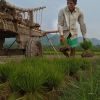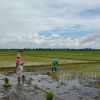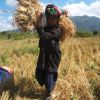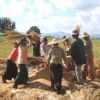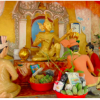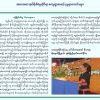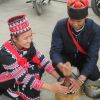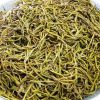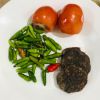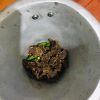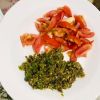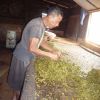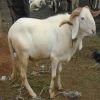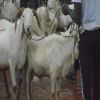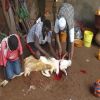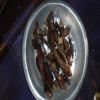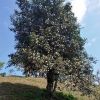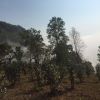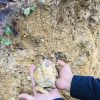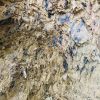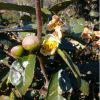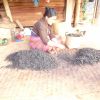Accession cards
The search found 65 results in 0.018 seconds.
Search results
Cultivating Rice in Covid-19 Times
COVID-19 is not the only challenge that common people across the world have been faced with. But there are places where this problem has been compounded due to other kinds of natural challenges felt locally. This has been particularly so in the state of Assam in India where annual flooding ravaged lives and livelihood. The worst hit have been the ones settled in low lying flood prone zones across the state, making it simply impossible for many to engage in cultivation of the staple food crop, rice.
Names of rice mainly grown in Rakhine under Burma Socialist Programme Party (BSPP) from 1962-1988
Ma Mya Than, 58 years old, is a middle class Rakhine (Arakanese) lady who lives in Buthidaung, a town in northern Rakhine. She used to sell various varieties of rice. Rakhine, situated on the western coast of Myanmar, is rich with natural resources including fish, timber, oil and gas. According to her, although Rakhine exported many acres of rice under Burmese Socialist Programme Party for years, there were around five types of rice that farmers in Rakhine mainly grew.
Unusual terms used to refer rice under BSPP
There existed unusual terms used to refer certain types of rice during the BSPP government. Here are three examples. U Myo Win Than is a 55 years old Burmese man who used to live in Myittha, Kyaukse district, Mandalay.
He explained that “Yar Kyaw Sa Par” refers to the variety which exceeds a hundred tinns (Burmese unit of volume measurement that equals to 40.9148 L) per acre when harvested.
Neglected Inheritance
Neglected Inheritance (or) Pa Oh Ethnic Traditional Rice Variety
The History of Tea Leaf
Image depicts a statue erected on Mt. Loi Saing (Paddamyar Taung in Burmese), near Taung Pė Village, situated within Namsam Township, northern Shan State. The statue goes that when the Burmese king Alaungsithu travelled across his new kingdom around the 5th -6th century, he found Palaung people at Loi San Mountain in Southern Shan State. When he found them to be poor and struggling, he gave them laphet seeds believing it would help them find money for their family.
Farmers and Loan Money “Amadaw Kyay” Under BSPP
Daw May Myo Khine, 49 years old, who once lived in Sittwe, capital of Rakhine, and whose grandfather and father owned many rice farms explained that under the Burmese Socialist Programme Party, some farmers grew two different kinds of rice. They grew low quality rice, which they would sell to the government at the prescribed price and good quality variety, which they would eat themselves. The government gave farmers loans called “Amadaw Kyay” for growing rice. In return, the farmers had to sell the harvested rice to the government.
Woman Led Self-Reliance Family
Woman Led Self-Reliance Family
I would like to share something with you about an ethnic Lahu family in Southern Shan State, Myanmar. This is a women-led family and they are relying on their own farm for their family foods and income generation. She is Daw Thida Aung with 52 years old and her husband is a religious leader. The family consists of four family members with her husband, a daughter and son.
Tea Leaf (Laphet) in Myanmar
Tea leaf is a Myanmar language called Laphet. Laphet is the meaning of tea plant, pickled tea leaves, pickled tea leaves mixed with other ingredients and served up as a delicacy (Myanmar Encyclopedia, Vol.IV, 1981).
Problem of Yellow Color (Dye)
This report released by the Ministry of Health states their persistent monitoring and testing of food products to ensure health safety and promote the well-being of citizens. It further explains that on lab examinations, 43 brands of tea (pickled) on the Myanmar market contained significant traces of Auramine O. Auramine O is a diarylmethane dye used in fabric coloring processes and despite lacking any immediate affect on consumer health, is hazardous and harmful to the kidneys and liver, therefore unsuitable for consumption.
Traditional Soybean Cury
Famous Traditional PaOh Soybean Cury
This one of the most famous traditonal foods in our country, Myanmar, especially in Southern Shan State.
The PaOh ethnic group has been used to this kind of food since their ancestors. Soybean cury and the PaOh ethnic people are inseparable from their society.
They always use every ingredient (soybean, chilli, salt, tomato, peanut oil) in these foods from their local resources without buying from outsides.
Practice for High Quality
The first step in making steamed, pickled tea the traditional way is to evenly lay out the tea leaves on a reed or bamboo mat. Next, the tea is rolled out by hand. This is done by placing both hands side by side and gently pressing down on the tea leaves with the lower palm of both hands.The steady back and forth motion of the slowly rolls the tea leaves. More and more pressure is added as the tea leaves begin to roll and curl up. This process takes about 15 minutes. Locals may use tea rolling machines if they are available.
Tabaski Twenty Twenty (1)
The feast of Aîd El Kébir or tabaski is a Muslim feast. It involves prayers and the slaughter of animals (preferably sheep). This year, it coincided with the Covid 19 pandemic and its consequences. This explained the soaring prices of sheep in the market. The animals were exposed in the parks and on the streets to customers. The prices varied between sixty thousand (60,000 F cfa) to four hundred thousand (400,000 F cfa and up). Because of the high price of sheep, within twenty-four hours (24 hours) of the event, some Muslims could not have the sheep of their choice.
Tabaski Twenty Twenty (2)
The first activity on the feast day tabaski is group prayer in the public squares. Otherwise it will led in the mosques by the Imams who will be the first to slaughter their animals. After the immolation of the Imams from each zone, the rest of the community starts to slaughter their animal. Following the mechanical skinning of the animals, the meat is distributed at three levels: firstly, the share of the disadvantaged first, then the next of kin and the third part is for the family. This meat is consumed in different dishes, at least within the families.
Traditional Old Tea Tree
Tea cultivation is one of the main rural livelihoods seen in Kyaukme Township, Northern Shan State. It can be seen in the many hills around the area. In Kyaukme Township, tea plants have been cultivated naturally for many years. Botanically speaking, tea belongs to the genus Camellia, species Thea and family Theaceae. Tea is a perennial crop. Most tea plants are not allowed to grow more than 3 feet high. This is because tea cultivators prefer to keep the plant low as it is difficult to pick tea leaves when the tree is tall.
Tea Picking (Harvesting)
Tea trees are kept small by tea growers and are evergreen throughout the seasons. In their natural state, they can grow to be up to 30ft tall. However, tea growers keep their tea tress to within 4-5ft in height. This ensures that the tea trunk remains thick and encourages more leaf and branch growth. Tea growers do so to get as much leaves as possible from their trees as the leaves are the sole product of tea trees. Keeping the tea trees short makes tea harvest easier to harvest.
Edible Earth from a Mountain
I arrived at place that has a mountain with the edible earth. I found that the wonderful mountain earth is eaten by PaOh ethnic elders especially for women and pregnant women. They often eat the edible earth in two ways; first is fresh earth and second is baking the earth. Usually they put the edible earth in the traditional oven to have a good smell and better taste. They believe that it is good for their health and it helps for pregnant women to get their energy. Nowadays most of young generations don't know about the edible earth.
The Introduction of African Rice in Suriname
Genetic research into rice from the inlands of Suriname draws attention to the history of West Africans who were deported as slaves to this former Dutch colony. While there are many grains of Asian rice, Surinamese black rice, ‘Blaka aleisi’, turned out to be almost identical to rice farmed by Mande-speaking farmers in West Ivory Coast according to research by Tinde van Andel. This rice was rarely eaten but instead was sacrificed to ancestors and used in spiritual herbal baths.
The future development of locals
Tea blossoms that emerge from the tea tree are left intact during the harvest. These blossoms are pollinated and produce fruits that ripen around Thadingyut and Tazaungmone (around October and November). The most mature fruits fall to the ground and the fruits that remain are picked for the seeds. The capsule-like seeds are egg-shaped and turn slightly brown when ripe. Inside the capsule is 2 or 3 seed pods which contain 2 or 3 seeds.
Tea is a popular nature beverage
Dried tea leaf is mostly manufactured in March and April when enough sunshine is available. At that time, the leaves are saturated with oil. It is the best time to make dried tea leaf. It is known as Moe-ma-hmi, Shwe-Phi dried tea leaf. During the months of March and April, dried tea leaves become dry in a day. Then they are sorted out to be marketable. There are two kinds of dried tea leaf namely, hard dried tea leaf and soft dried tea leaf. The soft dried tea leaf is not curled up fully and leaf is thick. The hard dried tea leaf is fully curled up and the leaf is thin.
Pages
Site of knowledge & meaning
Concerns
- Agriculture (16) Apply Agriculture filter
- Rice (16) Apply Rice filter
- Women (12) Apply Women filter
- Food Cultivation (11) Apply Food Cultivation filter
- Food Preparation (11) Apply Food Preparation filter
- Food Variety (8) Apply Food Variety filter
- Street Food (8) Apply Street Food filter
- Economy (7) Apply Economy filter
- Food Consumption (7) Apply Food Consumption filter
- Community (6) Apply Community filter
- Gender (6) Apply Gender filter
- Place-making (6) Apply Place-making filter
- Health (5) Apply Health filter
- Language (5) Apply Language filter
- Religion (5) Apply Religion filter
- Ritual (5) Apply Ritual filter
- Children & Youth (4) Apply Children & Youth filter
- History (4) Apply History filter
- Hygiene (4) Apply Hygiene filter
- Identity (4) Apply Identity filter
- Modernisation (4) Apply Modernisation filter
- Animals & Livestock (3) Apply Animals & Livestock filter
- Community Knowledge (3) Apply Community Knowledge filter
- Food (In)Security (3) Apply Food (In)Security filter
- Livelihood (3) Apply Livelihood filter
- Music (3) Apply Music filter
- Pandemic (3) Apply Pandemic filter
- Tradition (3) Apply Tradition filter
- Colonialism (2) Apply Colonialism filter
- Commercialisation (2) Apply Commercialisation filter
- Politics & Bureaucracy (2) Apply Politics & Bureaucracy filter
- Public Space (2) Apply Public Space filter
- Sustainability (2) Apply Sustainability filter
- Access (1) Apply Access filter
- Accessibility (1) Apply Accessibility filter
- Afterlife (1) Apply Afterlife filter
- Belief (1) Apply Belief filter
- Changing Food Practices (1) Apply Changing Food Practices filter
- Citizenship (1) Apply Citizenship filter
- Climate (Change) (1) Apply Climate (Change) filter
- Consumer Culture (1) Apply Consumer Culture filter
- drinking tea is a traditional enjoyment (1) Apply drinking tea is a traditional enjoyment filter
- Essential in People (1) Apply Essential in People filter
- Ethnic Identity (1) Apply Ethnic Identity filter
- Family (1) Apply Family filter
- farmers (1) Apply farmers filter
- Festivals (1) Apply Festivals filter
- food (1) Apply food filter
- Generational Gaps (1) Apply Generational Gaps filter
- Group Identity (1) Apply Group Identity filter
- Knowledge Systems (1) Apply Knowledge Systems filter
- Men (1) Apply Men filter
- Migration (1) Apply Migration filter
- multi-culturalism (1) Apply multi-culturalism filter
- Myth & Legend (1) Apply Myth & Legend filter
- Nation & Nationalism (1) Apply Nation & Nationalism filter
- Neighbourhood (1) Apply Neighbourhood filter
- observation of nature (1) Apply observation of nature filter
- Oral Tradition (1) Apply Oral Tradition filter
- Slavery (1) Apply Slavery filter
- Spirits (1) Apply Spirits filter
- tea calendar for cultivation and production (1) Apply tea calendar for cultivation and production filter
- Trade (1) Apply Trade filter
- Transport & Infrastructure (1) Apply Transport & Infrastructure filter
- Urban Space (1) Apply Urban Space filter
- Urbanisation (1) Apply Urbanisation filter
Feeling & motive
- Exchange (9) Apply Exchange filter
- Celebration (6) Apply Celebration filter
- Disappearance (6) Apply Disappearance filter
- Pride (6) Apply Pride filter
- Concern (4) Apply Concern filter
- Passing Down (4) Apply Passing Down filter
- Loss (3) Apply Loss filter
- Preservation (3) Apply Preservation filter
- Adaptation (2) Apply Adaptation filter
- Independence (2) Apply Independence filter
- Learning (2) Apply Learning filter
- Memory (2) Apply Memory filter
- Survival (2) Apply Survival filter
- tea-related knowledge (2) Apply tea-related knowledge filter
- Access (1) Apply Access filter
- Agency (1) Apply Agency filter
- Autonomy (1) Apply Autonomy filter
- Awareness (1) Apply Awareness filter
- Care (1) Apply Care filter
- Carefulness (1) Apply Carefulness filter
- Change (1) Apply Change filter
- Charity (1) Apply Charity filter
- curiosity (1) Apply curiosity filter
- Empowerment (1) Apply Empowerment filter
- Exclusion (1) Apply Exclusion filter
- expression of gratitude (1) Apply expression of gratitude filter
- fascination (1) Apply fascination filter
- freshness taste of green tea (1) Apply freshness taste of green tea filter
- Fruits have many treasure (1) Apply Fruits have many treasure filter
- gift of nature (1) Apply gift of nature filter
- Gratitude (1) Apply Gratitude filter
- Growth (1) Apply Growth filter
- Happiness (1) Apply Happiness filter
- Improvisation (1) Apply Improvisation filter
- Inclusion (1) Apply Inclusion filter
- Neglect (1) Apply Neglect filter
- Nostalgia (1) Apply Nostalgia filter
- Ownership (1) Apply Ownership filter
- practical experience of mankind (1) Apply practical experience of mankind filter
- price benefits that quality of organic tea production (1) Apply price benefits that quality of organic tea production filter
- Reciprocity (1) Apply Reciprocity filter
- Reflection (1) Apply Reflection filter
- Resistance (1) Apply Resistance filter
- Salvation (1) Apply Salvation filter
- Security (1) Apply Security filter
- Self-reliance (1) Apply Self-reliance filter
- traditional way (1) Apply traditional way filter
- Transformation (1) Apply Transformation filter
- unique product of Myanmar (1) Apply unique product of Myanmar filter
Image contains
- Photograph(s) (29) Apply Photograph(s) filter
- illustration (2) Apply illustration filter
- Book or Article excerpt (1) Apply Book or Article excerpt filter
- Champorado (Filipino dessert) (1) Apply Champorado (Filipino dessert) filter
- Champurrado (Mexican beverage) (1) Apply Champurrado (Mexican beverage) filter
- Myanmar proverbs (1) Apply Myanmar proverbs filter
- Photograph (1) Apply Photograph filter
- Screenshot (1) Apply Screenshot filter




